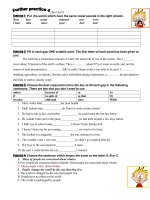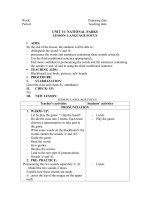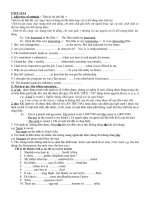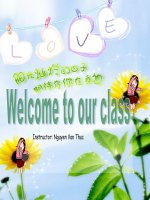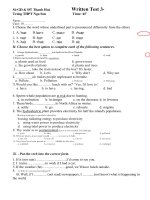Unit4-reading class10
Bạn đang xem bản rút gọn của tài liệu. Xem và tải ngay bản đầy đủ của tài liệu tại đây (1.11 MB, 31 trang )
Instructor: Nguyen Van Thuc
Activity 1: Look at these pictures and answer the
questions:
Picture1: What is she doing?
She is listening to music.
Picture2: What is he doing?
He is watching TV.
Picture3: What are they doing?
They are reading books.
Picture4: What is he doing?
He is singing and playing guitar.
Picture5: What is she doing?
She is dancing.
Activity 2: Answer the following
quizzes
1.What do you call the people
who can’t see? >>
2.What do you call the people
who can’t hear? >>
3.What do you call the people
who can’t speak? >>
The blind
The deaf
The dumb
Look at the pictures again. Then tell me
which activities you think would be difficult
for people who can’t speak, can’t hear or can’t
see.
Persons Difficult activities
The blind
………………
The dumb
…………………
The deaf
…………………
Activity 3: Look at the pictures and
answer the questions followed
1.Why is this
person using his
fingers to read?
2.What Alphabet do
the blind often
use?
Because They are blind
The Braille Alphabet
Look at t he Braille Alphabet and f ind out t he
message t hat f ollows.
… .……………… ……
Look at the pictures and answer the
questions followed
They are
dumb
1.Why are these
persons using
their hands to
communicate?
1. Can they attend normal class?
2. How do they need to education?
disabled [dɪs'eɪbld]
dumb [dʌm]
deaf [def]
mentally retarded ['mentəlɪ] [rɪ'tɑ:rdɪd]
opposition [, ɔpə'zɪ∫n]
prevent from [prɪ'vent]
time-consuming [taɪm] [kən'su:mɪŋ]
demonstration [demən'streɪ∫n]
proud of [prɑʊd] [əv]
gradually ['grædʒuəli]
tàn tật
câm
điếc
thiểu năng trí tuệ
sự phản đối
ngăn chặn
tốn thời gian
sự thể hiện
tự hào
dần dần
(adj)
(adj)
(v)
(adj)
(n)
(adj)
(adj)
(n)
(adj)
(adv)
Task 1: Answer questions
1.What are children learning in the class?
They’re learning how to read, write, add & subtract.
2.Why were there lots of opposition from their parents?
Because they believed that their children couldn’t learn
any thing at all.
3.What did Teacher-Thuy teach the children how to add and
subtract?
She raised both arms & opened up the fingers.
4. How do the children feel from their efforts?
They are proud of their efforts & they believe
their a new life.
Question 1 : Thuy’s class is different from other classes
because the children______
A. are from large families
B. are less mentally developed
C. love Maths very much
D. are disabled
Question 2: At first the parents were _____the idea of sending
their children to the special class.
A. interested in
B. opposed to
C. satisfied with
D. worried about
Task 2: Read the passage again and complete the
following sentences by circling the letter A, B, C or D
Question 3: It can be inferred from the second paragraph of
the reading passage that there has been__________ .
A. a change in the parents’ attitude towards the class
B. a lot of protest from the parents against the class
C. a feeling of doubt in the teacher’s ability
D. a belief in the parents’ opposition
Question 4: The writer describes how Thuy teaches the
children to add and subtract in order to prove that_____ .
A. the children like Maths
B. the teacher is proud of her work
C. the teaching work takes time
D. adding and subtracting are important
Question 5: The writers attitude towards Thuy’s
work in the passage can be described
as________ .
A. humorous
B. angry
C. suspicious
D. admiring
1
6
2
3
5
4
Task 2: Choose one of these stars below and answer the
questions behind them.
Task 3: Fill each the blanks of the summary below with
a suitable word from the box.
read write disabled efforts opposition
time- consuming Maths arms fingers proud
Twenty-five(1) _________children have the chance of learning
how to (2)_______and (3)_______ thanks to the (4)_______ of a
young teacher, Pham Thu Thuy.
Although her idea, at first, met with(5)__________from the
parents of the disabled children, more children attended her
class later.
The teaching work in the special class is (6)_____________. For
example, in a (7)_______ lesson, the teacher has to use
her(8)_______and (9)_______ to teach the children how to add
and subtract. The children are now (10)________and happy.
disabled
read write efforts
opposition
time-consuming
Maths
arms fingers
proud
( adj )
( v )( v ) ( n )
( n )
( adj )
( n )
( n )( n )
( adj )
-
Learn new words by heart
-
Prepare new lesson
HOMEWORK:
Look at these pictures
Who are
they?
What
are they
doing?
Where are
they?
They are
disabled
children.
They are in
special class
They are
learning
What should we do to help them?
